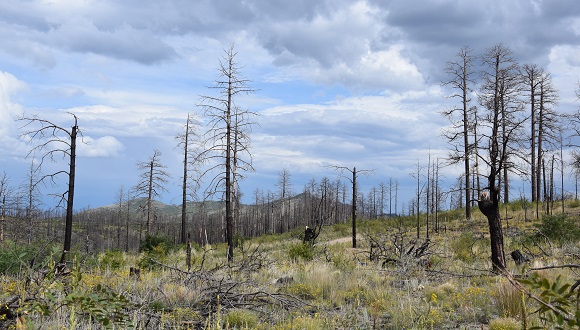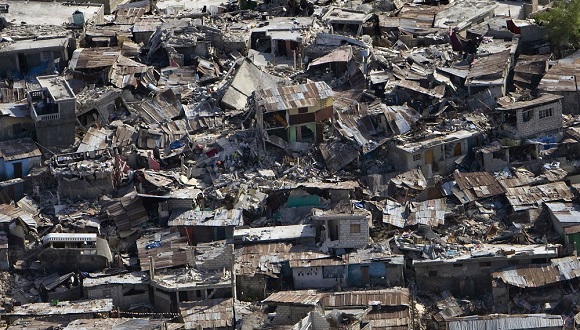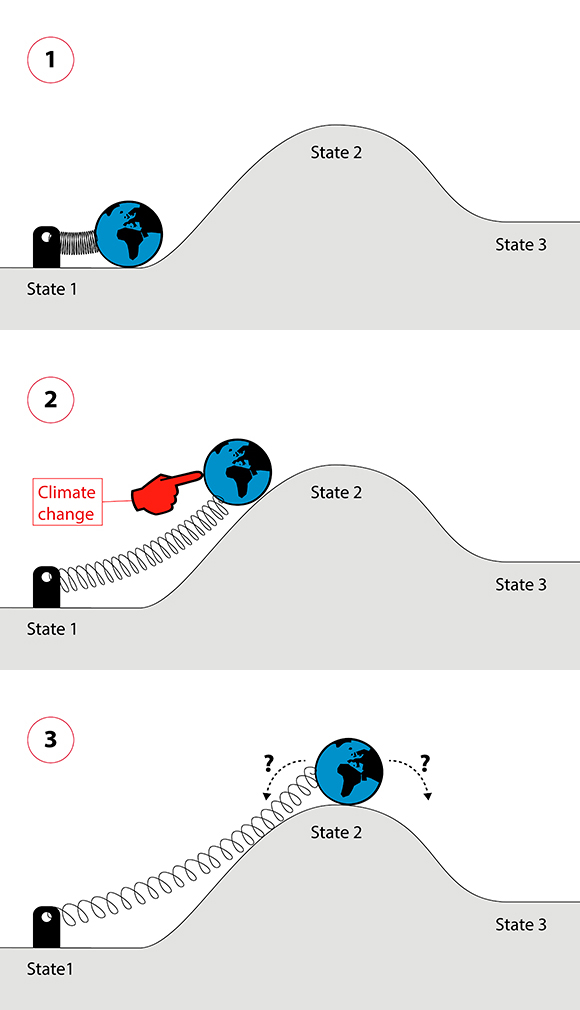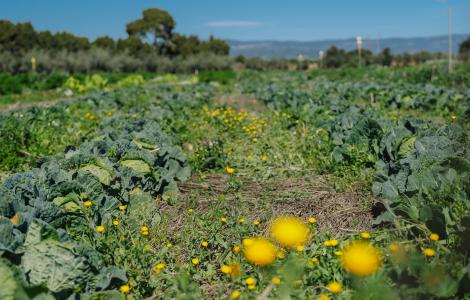Riding resilience
The use of the term 'resilience' has been extended. But success entails risks. When dealing with complex concepts encapsulated in a word, the risk translates into confusion. It is therefore worth entertaining the passage and meditate for a while.
![]()
To María Ángeles,
The weaknesses of ecological resilience
Ecological resilience is the capacity of a system to recover their properties after being modified by a disturbance. It is a concept used in physical science studying behavior of systems (such as resilience after catastrophic shut down of energy supply systems) or materials (for instance when subjected to deformation). However, this apparently simple idea does not like to all ecologists.
First, because the concept is formulated relative to a state prior disturbance, but (i) often it is hard to characterize this previous state, and (ii) conditions before the disturbance will never remain. The physical environment is continuing changing. Climate is a good example. The biota also is also in constant transformation; many organisms move around while their lineages evolve. Ecological systems are historical. As Ramon Margalef said: "the characteristics of a state at a given moment determine how the future state will be."
Secondly, the definition of 'disturbance' may have some arbitrariness. Intuitively we would say that it corresponds to a situation where a significant part of the biomass of an ecosystem is rapidly destroyed, while the environment gets modified. This modification generally implies a greater availability of some resource, for example the light after a windstorm that opens gaps in the forest. Fires are a typical example of disturbance, and Mediterranean vegetation is considered very resilient to them by their ability to subsequently reestablish. However, there may be potentially disturbing agents with a low impact. There may also be situations in which the temporal variability of the environment leads to significant mortalities, but we find difficulties to attribute them to disturbances, as in the case of prolonged periods of drought. In addition, the sequence of perturbations is important. Resilience to a disturbance may depend on the intensity and frequency of previous perturbations - what we call the 'disturbance regime'. In short, not only the previous stage is relative, but the very nature of the disturbing agent and the alterations it produces.
Third, an ecological system is characterized in many ways: its species composition or its ability to assimilate energy and recycle matter are the most outstanding. The easiest way to apply the concept of 'resilience' is to measure these different properties over time after the disturbance and compare the measurements with the previous reference system. But the behavior of the different properties of the ecosystem is surely not identical. Species composition can be very resilient after a wildfire, at the same time as soil losses occur and productivity decreases. Or the productivity of a forest can be recovered after a hurricane thanks to the activity of species that were not found before the disturbance. Therefore, resilience is also a relative term insofar as it refers to a particular property of the system and it is extremely difficult to have a single integrated measure of all the properties of the system.

How to study ecological resilience
A solution to the first problem - to establish the reference state - is to recognize resilience as a tendency, whose speed is worthy of consideration, regardless of the initial state; the relevant question is the predictable trajectory and the mechanisms that promote it. This may allow setting thresholds where some fundamental property of the system substantially changes or that determine the return of properties to their initial values.
The problem of determining the characteristics of the disturbance involves dimensioning and playing with the temporal scale. For example, climate change appears as gradual when we observe it from year to year, but emerges as much more pronounced when we consider it on a scale of decades. In addition, this consideration of the temporal scale allows the analysis of the disturbance regime. We can also assess the impact of the disturbance relative to its magnitude by differentiating the immediate effect, what we call 'resistance', of the later recovery, 'resilience' properly.
Finally, to address the problem of the multiple properties of the system we must define them correctly and find good indicators of them. In fact, the study of the different behavior of these properties is an attractive intellectual game that can help to better understand its functioning.

Resilience from other perspectives
To the difficulties of ecology with resilience, the use of that term in other areas does not help. In the 1970s, psychologists introduced it to describe the individual's ability to successfully adapt to adverse, often traumatic, social conditions (such as alcoholic or mentally ill parents). It is interesting that resilience in this area is considered a process, not a property, reinforcing the idea of individual’s adaptation, in contrast to that of predisposition. The term was soon used from an epidemiological perspective and extended to the social and political sciences. Thus the idea of 'community resilience' appeared, which considers the mechanisms that human society has to face adversities and reorganize and improve later.
It is not surprising that a term that describes concepts with different nuances, and that floats between academic fields, is replayed by a new discipline that emerges from all of them. This is the case of socioecology or disciplines dedicated to environmental sustainability. There have even raised groups of experts on resilience, such as the Stockohlm Resilience Center, or specialized journals. For these experts, resilience describes the ability of a system to cope with change and to continue developing. Logically, in this area the changes are associated with environmental transformations promoted by human societies, such as climate change, although the concept is highly transversal.

If, after this journey, we compare the 'ecological resilience' of the beginning with 'psychological or community resilience' and with 'socioecological resilience' we can make some interesting considerations. In the first place, the previous state of the system has been losing its relevance, which probably has more advantages than inconvenience, often even for ecologists. Secondly, the idea of disturbance is amplified, from a traumatic change to any adverse factor or even to any environmental change. Considering changes more generally allows addressing situations, such as climate change, in which the concept of disturbance can be confusing or relative. In addition, the idea of adaptation, in a social sense, is not so far from the study of the mechanisms that explain the more or less resilient response of ecological systems. Third, although ecology would initially analyze the properties of the system independently of its social value, the study of ecosystem services gains day-to-day relevance among ecologists.
A principle of synthesis
How to use the same term with all these nuances when used in related disciplines? The first step is obvious: define the scope as clearly as possible. In the case of resilience, it is necessary to clearly establish the initial or reference conditions, the characteristics of the disturbances taking particular account of the time scale, and the properties of the system considered. But it can also be very interesting to take advantage of these different nuances to emphasize the different connotations of a study system.
Let's look at the example of forest resilience to climate change. From the strictly ecological point of view, we must define the extent to which climate change becomes a disturbance. For sure, there may be pulses of climatic variation, such as heat waves or drought episodes, which fit well enough to the concept of traumatic disturbance. But in general, to consider climate change as a disturbance, we surely need time periods of several decades or centuries. Thus we can compare the ecological properties before and after the industrial era, see their modifications and the eventual recovery or resilience. Meanwhile, at shorter time scales, we can study the processes that would explain those changes in the longer term. We are, therefore, approaching the idea of change found in 'socioecological resilience' and of adaptation to an adverse environment of 'psychological resilience'. In addition, when ecology faces the study of ecosystem services, the temporal scale of anthropogenic impacts tends to be reduced; thus we get closer to the meaning of 'socioecological resilience'.
In conclusion, in front of a term used by different disciplines to define complex concepts, the first recommendation is to define clearly its meaning in the field that is applied. But once done, the second recommendation is not to be afraid of cross-fertilization between disciplines that will enrich the prospects and help find better solutions to problems.







